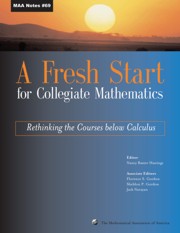Book contents
- Frontmatter
- Preface
- Contents
- Introduction
- Background
- 3 Who are the Students Who Take Precalculus?
- 4 Enrollment Flow to and from Courses Below Calculus
- 5 What Have We Learned from Calculus Reform? The Road to Conceptual Understanding
- 6 Calculus and Introductory College Mathematics: Current Trends and Future Directions
- Theme 1 New Visions for Introductory Collegiate Mathematics
- Theme 2 The Transition from High School to College
- Theme 3 The Needs of Other Disciplines
- Theme 4 Student Learning and Research
- Theme 5 Implementation
- Theme 6 Influencing the Mathematics Community
- Ideas and Projects that Work: Part 1
- Ideas and Projects that Work: Part 2
6 - Calculus and Introductory College Mathematics: Current Trends and Future Directions
from Background
- Frontmatter
- Preface
- Contents
- Introduction
- Background
- 3 Who are the Students Who Take Precalculus?
- 4 Enrollment Flow to and from Courses Below Calculus
- 5 What Have We Learned from Calculus Reform? The Road to Conceptual Understanding
- 6 Calculus and Introductory College Mathematics: Current Trends and Future Directions
- Theme 1 New Visions for Introductory Collegiate Mathematics
- Theme 2 The Transition from High School to College
- Theme 3 The Needs of Other Disciplines
- Theme 4 Student Learning and Research
- Theme 5 Implementation
- Theme 6 Influencing the Mathematics Community
- Ideas and Projects that Work: Part 1
- Ideas and Projects that Work: Part 2
Summary
Introduction
For better or worse, the ideas of calculus reform are deeply embedded in the conversations of the mathematics community. Technology, cooperative learning, student projects, applications—the elements of this movement—have become a part of the vocabulary in mathematics departments across the country. Efforts to change the nature of the calculus course at the undergraduate and secondary levels have sparked discussion and controversy in ways as diverse as the actual changes. Such interactions range from “coffee pot conversations” to university curriculum committee agendas to special sessions on undergraduate education at regional and national conferences. But what is the significance of these activities? Where have we been and where are we going with calculus and, more importantly, the entire scope of introductory college mathematics?
The observations to follow are based in part on two studies conducted for the National Science Foundation (NSF) in the late 1990s: one to determine the national impact of the calculus reform movement since 1988, and a second that examined the subsequent NSF Institutional Reform (IR) Program. The study of calculus reform resulted in countless communications with the mathematics community and others about the status of calculus, while the IR study examined the ability of institutions to integrate science and mathematics across disciplinary boundaries and create an environment for learning that encourages science literacy for all students at the undergraduate level. The outcomes from these studies (reported in [1] and [2]) suggest the importance of considering the following series of questions:
What exactly have we learned about the teaching of introductory college mathematics?
[…]
- Type
- Chapter
- Information
- A Fresh Start for Collegiate MathematicsRethinking the Courses below Calculus, pp. 46 - 54Publisher: Mathematical Association of AmericaPrint publication year: 2006

